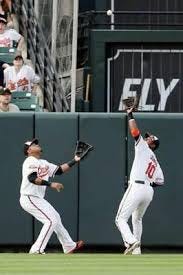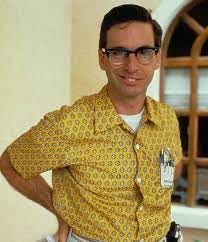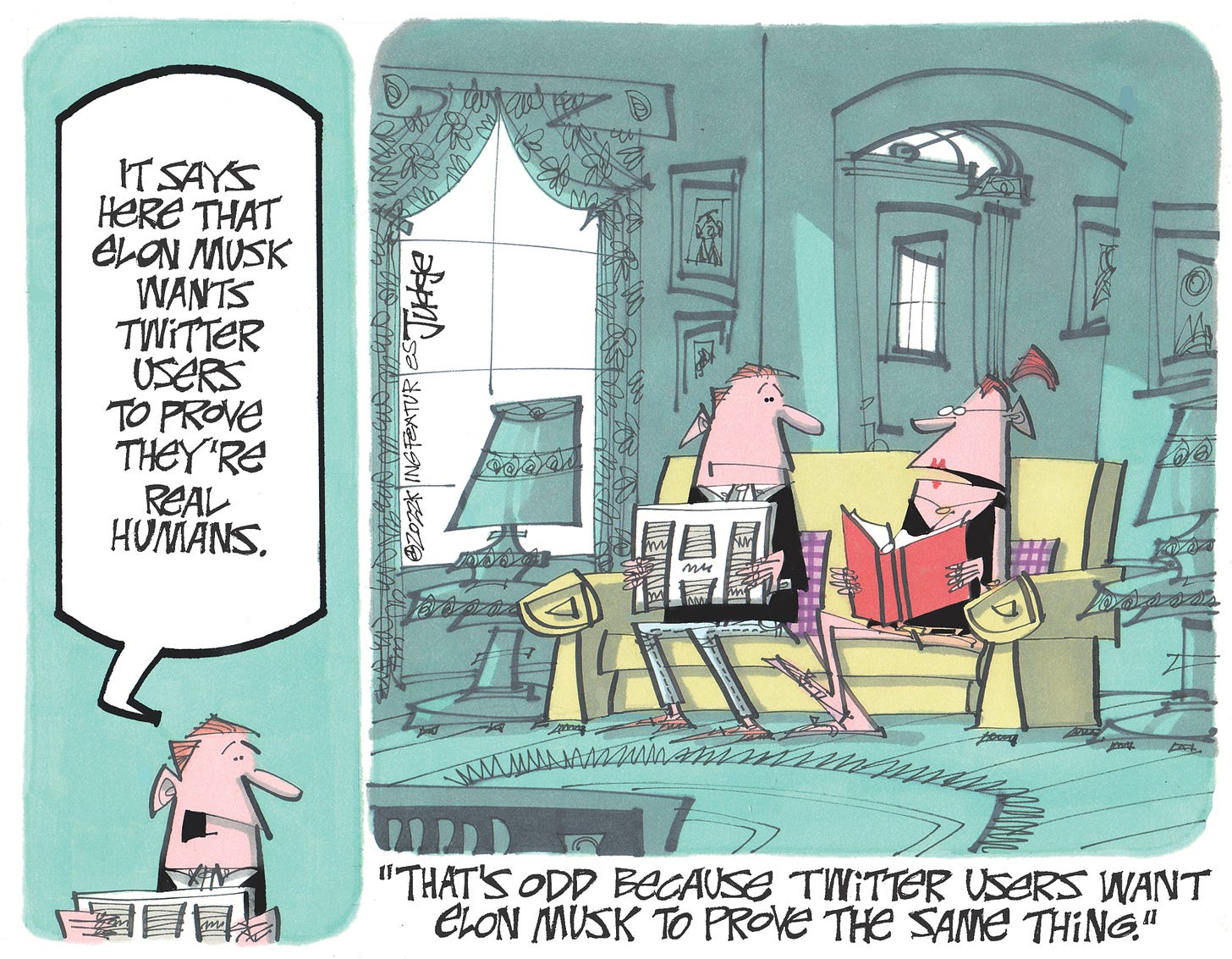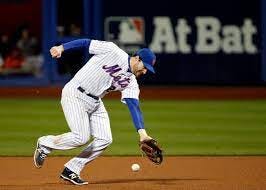A while back I promised (or maybe it was threatened) to write a piece telling fans how to spot a bad outfielder and today it’s time to keep that promise and/or threat.
Just in case you’ve forgotten or made the mistake of not reading the first article, all outfield positioning is done off the “straight up” position and once again here’s what that means:
Walk from first base to second base and then continue walking for 70-to-75 steps and you’ve reached the left fielder’s “straight up” position.
Walk from third base to second base, continuing walking for 70-to-75 steps and you’ve reached the right fielder’s “straight up” position.
Walk from home plate to second base, continue walking for 70-to-75 steps and you’ve kinda reached the center fielder’s “straight up” position, but the centerfielder can’t play true straight up because then he’d be looking at the pitcher’s back which would block his view of home plate.
That’s how outfielders are supposed to position themselves: in relation to second base because second base is always in the same place no matter what ballpark you play in, but that’s not how bad outfielders do it.
Check the outfielder’s depth
Just in case you’ve never played the outfield: going back on a fly ball is more difficult than coming in, so bad outfielders play too deep and position themselves in relation to the wall behind them.
Bad outfielders play six steps off the warning track no matter what ballpark they’re in.
Do that in Kauffman Stadium (which is a really big park) and an outfielder is too far from the infield and catchable balls drop in for hits and the outfielder is also too far away to throw anybody out, so we watch a rally and blame the pitcher when it might be the fault of his outfielders who are afraid to play close enough to help him.
If you want to spot a bad outfielder, look for “tweeners” — balls in-between the infield and outfield — that drop in for hits that could have been caught if the outfielder had the guts and/or skill to play in.
Watch what happens when they hit the warning track
The correct way to play a fly ball near a wall is to run hard, get to the wall ASAP, reach out and touch the wall so you know where you are and then adjust: come away from the wall to make a catch or get ready to make a leap on a ball that’s over a wall.
But bad outfielders aren’t comfortable doing that because it involves running hard and getting close to the wall (and walls tend to be pretty damn solid, even with that padding) so bad outfielders tend to drift instead of sprinting and slow up once they hit the warning track.
That’s when you might see a bad outfielder who’s afraid to get near the wall, jump to make a difficult a catch on a fly ball that could have been caught easily if he’d gone all the way to the wall to begin with.
Fun fact:
Warning tracks are not all the same width (which seems like something baseball really ought to fix) so an outfielder needs to remember what park he’s in because the warning track might be one width in Kansas City and another in Baltimore and last time I checked, Toronto didn’t even have a warning track; they just made the artificial turf a different color which looks fine on TV, but does absolutely nothing to warn an outfielder he’s about to collide with a wall.
The “warning” part of “warning track” comes when an outfielder feels his feet go from grass to dirt because at that point he’s pretty much focused on the ball and it’s hard to feel yourself go from green artificial turf to brown artificial turf.
So if you see an outfielder pull up short in Toronto, it’s kinda hard to blame him.
Watch their routes
There’s a metric called “route efficiency” and it’s a bad metric because it’s based on the completely erroneous idea that the best route to field a batted ball is a straight line from Point A. to Point B. and it’s not.
(This is why you don’t want guys who never played baseball coming up with bad metrics, but we’ll achieve Peace in Our Time before they stop doing it.)
Whenever possible, outfielders want to field a ball while headed back toward the infield and that means running to a point behind where the ball will land and then coming forward and since humans aren’t robots (although I’m not entirely sure about Elon Musk) and don’t make sharp 90-degree turns, the routes are curved and shaped like a banana which is why they’re called “banana routes” which sounds like something involving a fruit salesman, but isn’t.
Now enjoy this completely unnecessary Elon Musk cartoon:
Now here’s a video demonstrating a banana route and the guy is talking about infielders fielding the ball while headed toward first base, but the same principle holds true for outfielders:
Good baserunners pay attention to routes and if an outfielder is headed away from second base when he fields the ball, the throw won’t be as strong and a single might get turned into a double when the runner takes an extra 90 feet.
Alex Gordon was a master at running routes and turned a lot of doubles into singles by running hard and fielding a ball while headed back toward second base and since he had a great arm and quick release, smart baserunners shut it down early and decided to be happy with a single.
But running a good route means running farther and harder and bad outfielders don’t want to do that because…
Bad outfielders are lazy
If you want to understand baseball and who’s good at it and who’s not, once in a while you need to take your eye off the ball.
For instance:
When a batter singles to left with nobody on, look at the right fielder and see if he’s running hard to back up second base which is where the throw is headed.
When someone steals second base, sneak a peek at the centerfielder: if the ball is not put in play, the centerfielder should be running hard to back up second base and anytime a catcher’s throw gets away and the runner jumps up and takes third, that might mean the centerfielder got lazy or played too deep or some front office analytics dude had him positioned too far away in a gap and he wasn’t there to stop the runner from taking an extra 90 feet.
Also, after a foul ball, check the outfielders to see if they moved their feet.
All defenders (with the exception of the catcher) should be moving forward as a pitch is delivered because it puts them on the balls of their feet, but if an outfielder gets lazy and loses focus (which is really easy to do out there and I know because I’ve done it) he won’t move his feet and he’ll just turn his head and watch the ball go foul.
Watch how they catch a fly ball with runners on base
There’s a whole bunch of stuff I could talk about when it comes to outfield fundamentals, but we’ll focus on just one: how an outfielder catches a fly ball with a runner on base.
If nobody’s on base, an outfielder can catch a fly ball any way he wants to, but if there’s a runner on base and less than two outs, good outfielders will get behind where the fly ball is going to land and catch it moving forward, which adds momentum to their throw and they’ll catch the ball over their throwing-side shoulder which closes up the front shoulder and speeds up the release of the throw.
Bad outfielders are just relieved to catch the ball at all and often fail to do the extra stuff that prevents a runner from tagging up and taking an extra base.
Also…(OK, so I wrote about two things)…
Bad outfielders will sometimes panic and overthrow the cutoff man and launch a SCUD missile toward home plate and if a throw from the outfield is too high and can’t be cut off, trail runners can take an extra base.
The main cause of bad outfielders
People into analytics often put way too much emphasis on offense and way too little on defense even though preventing a run is just as important as scoring one, but defense is hard to measure, so people who only understand the game through numbers tend to focus on the offensive side of the ball.
Because people into analytics (and those are the people running teams these days) value offense more than defense, they’re often willing to play a lousy defender as long as he hits enough home runs.
If you’ve got a bad defender you put him in a corner outfield spot because centerfield is just too big and he’ll get exposed which, by the way, is how those skinny “fly guys” (guys who can run) make a living. Fans are asking why do we want a .250 lifetime hitter with no power and the answer is you need that no-power guy to catch all the balls those 30-home-run guys playing right and left field can’t get to.
And if other teams are going to play bad defenders you need to avoid strikeouts and get the ball in play and expose those bad defenders, which is what the 2014 and 2015 Royals did and if you think back, many of the key turning points in those postseason games were based on the other team making a defensive mistake.
Casey Stengel once said something like he wasn’t in favor of guys who drive in one, but let in two (or drive in two, but let in three, or drive in three or let in four…I can’t remember the exact numbers Casey used) but his point was this:
If a player allows more runs on defense than he produces on offense, he’s not a winning player.
The bad outfielder might be killing his team by playing too deep and running horseshit routes or pulling up when he hits the warning track, but since fans and the media don’t pay much attention to these fundamentals, everybody loves the guy because he drives in runs.
It’s right there in front of us (although TV needs to do a better job of showing outfield positioning because they often ignore it, too).
But if you’re actually at the ballpark you can see who plays deep when they shouldn’t and allows catchable balls to fall in and now you know what to look for and can explain it to friends and complete strangers, so feel free to do that even though it’s probably going to piss everybody off when you tell them that 30-home-run right fielder is actually a losing ballplayer and the no-power “fly guy” in centerfield is actually doing more to help his team win.
A word before I go
While looking for internet pictures of outfielders screwing up, I couldn’t help but notice all the Twitter Toughguys who never actually play baseball making fun of the guys who do, but all the things we talked about (going back on a ball, playing the wall correctly, running good routes) and a couple we didn’t (fly balls in the sun, pop flies on windy days) are really, really difficult and maybe we ought to appreciate it when someone does those things well instead of ridiculing them when they don’t.
Now go watch a baseball game and give a round of applause to the next guy you see run a good route and turn a double into a single, even though everybody around you is going to wonder what the hell you’re excited about.










So good, Lee. And I’m pretty sure it’s not as easy as it looks to sort through and explain fundamentals.
Can’t wait to watch a ballgame.
“If a player allows more runs on defense than he produces on offense, he’s not a winning player.” I’m putting this on a pillow.
Great piece. I'll be pondering it all day!